Something about this part of the city radiates power and spirituality. The Roman Forum neighborhood is the heart of one of Thessaloniki’s most interesting areas for contemporary culture. It’s also home to monuments from Thessaloniki’s Roman, Byzantine, and Ottoman eras, all within sight and just a three-minute walk of each other. In this central and beautiful part of the city are centuries of memory and culture.
Experience the Monuments of the Roman Agora Neighborhood – What to See and Do
Besides the Agora itself – one of Thessaloniki’s premier Roman sites, there is also the best preserved Ottoman Hamam in the city, plus two UNESCO World Heritage monuments. These are the Byzantine churches Agios Dimitrios and Panagia Chalkeon.
Imagine the Life of Roman Thessaloniki in the Ancient Roman Agora
It’s very easy to picture the life of 2nd Century AD in the Roman Forum of Thessaloniki – the crowds dressed to be seen on an evening at the Odeon, shopping and haggling along the Stoas, emerging refreshed and relaxed after a session at the public baths. The Agora was the center of public life in the city from the 2nd century AD. The photogenic Odeon, the Stoas, the ruins of the Roman Bath, and the Cryptoporticus are all easy to spot. Stroll through, and then find the museum that’s hidden like a secret underground in the northwest corner. The small museum has a great introduction to the the history of the city.
Las Incantadas – “I Magemenes” – the Lost Monument of the Roman Agora of Thessalioniki
The most famous Roman Monument of Thessaloniki was once just a few meters southeast of the Roman Agora. The top story of this two story collonade had mesmerizing Karyatid-like figures. The figures has two sides. On one side, representing Nike, Aura, Castor or Pollux (known together as the Dioskuri), and the abduction of Ganymede. On the other side were a Maenad, Dionysus, Ariadne, and Leda with Zeus as a swan (the union which fathered Pollux).
The French paleographer Emmanuel Miller coveted Las Incantadas. In 1864, he removed them – destroying them in part. They’re now in the Louvre. But you can see casts of Las Incantadas are now at the entrance to the Archaeological Museum of Thessaloniki.
Why the Spanish-sounding name? Las Incantadas is Ladino – Judeo-Spanish – for “The Enchanted Ones.” Las Incantadas were in the heart of the Jewish quarter of the city. For much of the Thessaloniki’s history, Jews made up the majority of the multicultural population.
Join the Pilgrims at Agios Dimitrios
The church of Thessaloniki’s patron Saint – now a grand five aisled basilica – has seen many lives. The crypt is the former Roman bath house and is now a museum. The saint is said to have been imprisoned and martyred here. And from the marble fountain once flowed holy myrrh. Dimitrios is an important Orthodox saint. A center for pilgrimage, Agios Dimitrios church has long opening hours. It’s often crowded, and even festive.
Drink a Coffee on the Roof of a 15th-century Hamam
The Bey Hamam was built in 1444 – shortly after the Ottomans conquered the city. Older citizens alive today remember bathing here – it only closed after over five centuries of use, in 1968. The bathing chambers of the Bey Hamam now sometimes host exhibitions. Over the main entrance you can see an elaborate muqarnas, with traces of blue paint. You can still relax at the Bey Hamam with a coffee or a glass of wine. Around the side of the side of the building is the Palio Hamam cafe. There’s seating inside and you can also go upstairs to the roof terrace, set among the many tiled domes of the hamam. It’s an unusual and exotic slice of urban landscape.
Smell the Roses in the Sunken Garden of Panagia Chalkeon
Imagine the Byzantine city at the Panagia Chalkeon. This church of 1028 is a full story below street level and shows us how much the topography of the city changed over the next 400 years. The sunken gardens around the Church of the Panagia Chalkeon, in the heart of the noisiest part of downtown, are tranquil and fragrant with roses. This UNESCO World Heritage monument is a beauty. A cross-in-square style church, it has a unique sense of space. Admire the original frescoes – this is one of Thessaloniki’s more colorful churches.
The name Panagia Chalkeon means “The Virgin of the Copper smiths.” This was the neighborhood of the coppersmiths in the Byzantne era. And a millennium later, it still is – there’s a copper smith just a few meters from here, down the p edestrian street Klisouras. During the Ottoman occupation, when the church was converted for use as a mosque, it was called the Kazancilar Tzami – mosque of the cauldron-makers – or copper smiths.
Check Out the Architecture in Thessaloniki’s Most Elegant Pre-War Neighborhood
The great fire of 1917 destroyed a huge part of Thessaloniki, and nearly all of the city center, including this whole neighborhood. The densely built center of tangled alleys was gone overnight. There was a new city plan, developed by the French architect, archaeologist, and urban planner Ernest Hebrard, that included gland plazas, parks and boulevards. This central location was prime real estate. Thessaloniki’s first apartment buildings were built here, and in excellent style, with high ceilings and sumptuous neoclassical details.
Buy a Little Piece of Old Thessaloniki at the Bit Bazaar
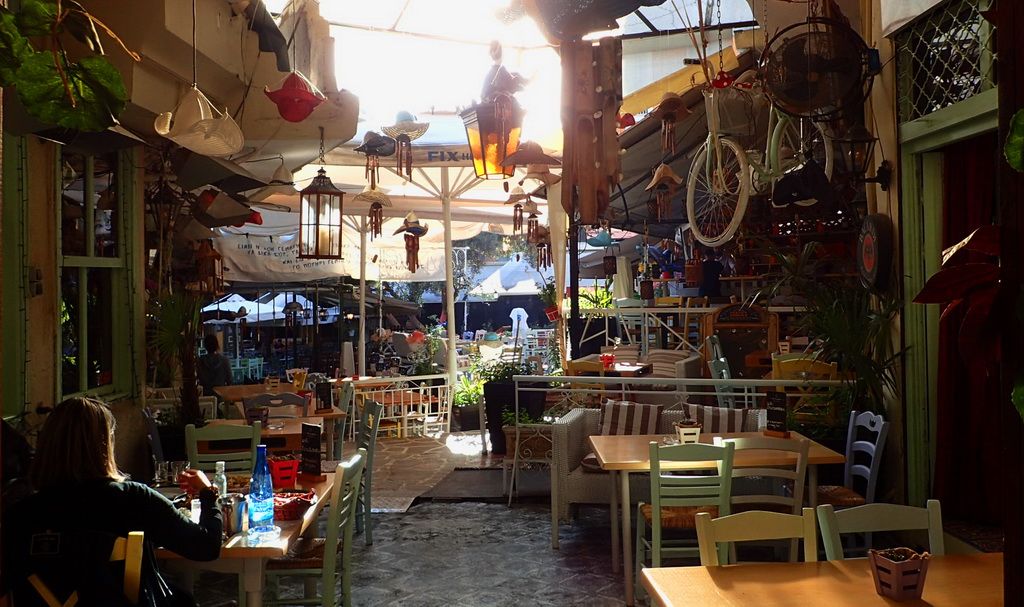
One street west of the Roman Agora is Tositsa, a diagonal street connecting Filippou and Olympou – the streets that border the south and north of the Roman Agora. This whole area is often referred to as the “Bit Bazaar,” for the flea market of the same name. The whole street is lined with pleasingly shabby antique stores. In the middle of the block is the entrance to an antique-filled courtyard – this is the Bit Bazaar, named for the Turkish word for Flea Market. In the 1920’s hundreds of thousands of refugees from Asia Minor settled in Thessaloniki. Some of them settled here, and sold what they could to get by.
…And Dress the Part
One of the best vintage clothing stores in Thessaloniki is right by the Bazaar. On the pedestrian street Karmpola you’ll find the Vaudeville Room – gorgeous vintage finery hand-picked from London and Budapest. It’s all displayed in a ground-floor pre-war apartment – ring the bell and its the door on the right when you enter.
Do you have more time in the city? Then indulge your nostalgia in style and visit designer Eleni Chasioti for a bespoke vintage look. Her designs are inspired by the fashions of the 1930’s and 1940’s. You’ll find her on the other side of the park.
Rediscover Vinyl
Of course you already have. So you’ll feel right at home at To Pikap. At this collective, you’ll find records upstairs, along with art exhibitions and/or clothing from local designers. There are live DJ sets and concerts. This is an all-around analogue-friendly experience. And also just plain friendly.
The Freshest Nuts at the Oldest Shop
Greeks love nuts and dried fruits. Every neighborhood has one or more specialty stores stocking everything from roasted pistachios from the island of Aegina to dried exotic fruits. At Iraklis (Hercules), the freshest quality nuts are stored in the original display cases at this family owned shop. It’s a city favorite, open since 1939. Pick something up to have in your hotel room later.
See Some Contemporary Art at the Roman Agora
Thessaloniki is an excellent destination for contemporary art – see local, Greek, and international artists at the Thessaloniki branch of Nitra Gallery, on Filippou east of the Roman Agora.
Where to Drink Around the Roman Agora Thessaloniki – Best Bars and Cafes
Get Decked Out (While You Sip a Brilliant Cocktail)
Our absolute favorite artisan jewelry shop is also out favorite place to get a cocktail. You’d never find either of them, at the back of a commercial arcade in a mid-century office building. We love Bord de l’eau for Giannis Gounardi’s magical designs – the masterfully crafted animal rings are like little surreal works of art. The multi-purpose space is a great place to work during the day, and the cocktail lounge is fun and inviting. The music is on point. And if you’re drinking, trust the peerless and playful mixologist.
Have Coffee in Style
You have your pick of ideal coffee places on the northeast corner of the Roman Agora. For an unbeatable view, try the Blues Bar, whose outdoor tables overlook the Odeon. To take in more of the neighborhood’s pre-war elegance, go to the minimalist Cafe Lux, where a young crowd gathers around classic marble cafe tables under a soaring ceiling.
What to Eat around the Roman Agora Thessaloniki – Restaurants, Meze, Patsas
Have a Classic Meze around the Bit Bazaar
The bazaar is surrounded by the sounds and flavors of Asia Minor. Any one of the very casual tavernas or cafes will have a selection of inexpensive meze – snacks to have with wine or tsipouro – as Rebetiko plays. Wine will come in an aluminum carafe and is served in short tumblers. If you’re new to drinking here, remember that you toast more often – a lot more often. “Yiamas!” – to our health.
Taste the New Wave Playful Gourmet Cuisine at Kitsch kai S’efaga
Thessaloniki has a wave of modern and inventive bistros that offer a fresh take on the city’s serious culinary heritage. Of these, Kaitsch kai S’efaga (kitsch and I ate you) is one of the most fun. The whimsical and surreal decor give you a hint of the creativity going on in the kitchen. The playful dishes have prime local ingredients, meticulously sourced. You’ll dine like a queen, and pay like a student.
Get Initiated into Thessaloniki’s After Hours’ Culture at Tsarouchas
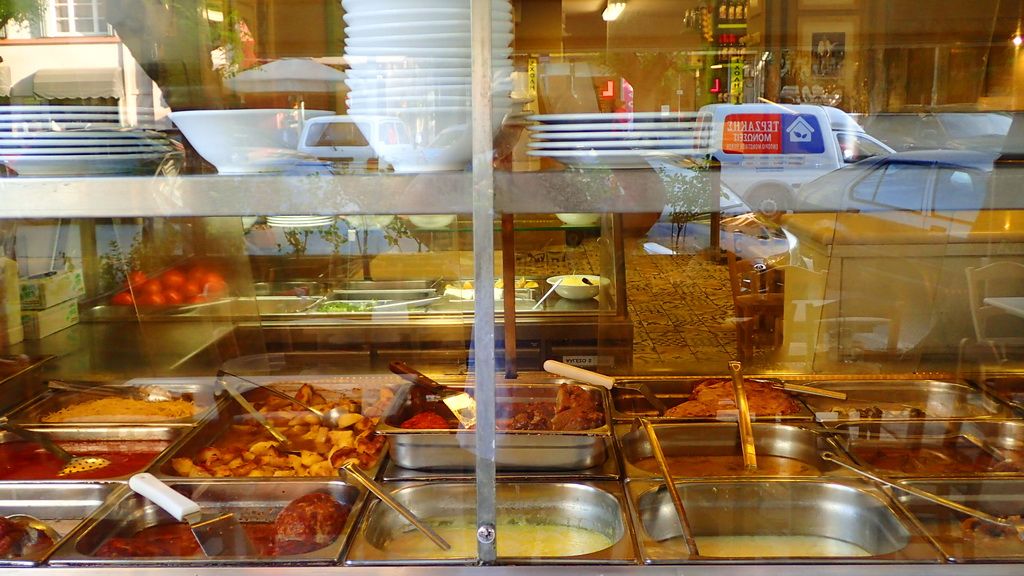
In a city famous for its late night, there are two ways to end the evening. One is getting a bougatsa, because by 5 or 6 the best bougatsa shops should be just getting started. But the other – a bowl of “Patsas” – is a cult late-night ritual. Join Lou Reed, Nick Cave, many Greek politicians and film stars, and Rebetiko musicians for a bowl of this potent elixir. It’s said to reverse everything from aging to – most relevantly – impending hangovers. Who knew that boiled tripe, belly, and trotters had such magical powers?
Tsarouchas is open 24 hours a day.
Where to Stay in the Roman Agora Neighborhood
This is a terrific neighborhood to stay in. It’s central and very close to the nightlife centers of town. But the neighborhood itself is quiet at night – it’s full of cafes and restaurants rather than bars and clubs. There are also interesting places to stay – convenient and with plenty of character.
Gato Perso for Retro Elegance
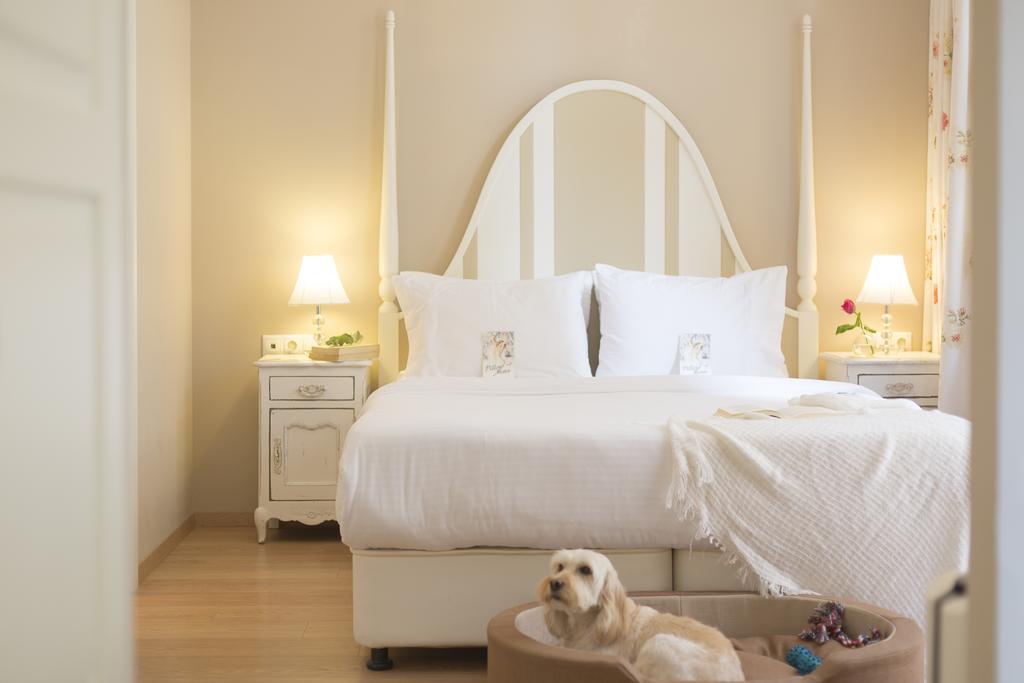
Just steps from the Roman Agora on a quiet street, you’ll find the stylish Gatto Perso. This 1926 building has lovely Art Deco and Neoclassical details, and has been carefully restored with all period details intact, and all modern amenities added. The decor combines contemporary elegance – in the marble baths and sleek kitchen facilities, and period charm in the furnishings, wall treatments, and drapes.These luxury serviced apartments are a good choice for families – and dogs! For the latest prices and availability, please check here.
Egnatia Palace
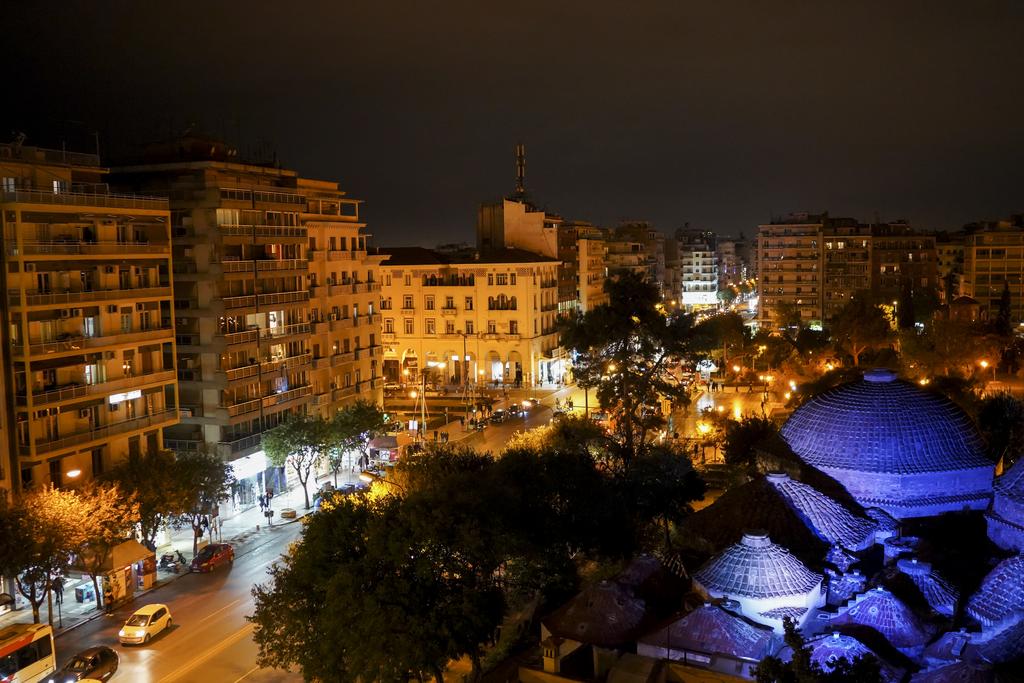
Overlooking the Bey Hamam, the 4-star Egnatia Palace Hotel and Spa gets consistently high marks from guests, with a 9.5 rating for location. The hotel is also just steps from Aristotle Square. For reviews, prices, and availability, please see here.
Antigon Urban Chic Hotel –
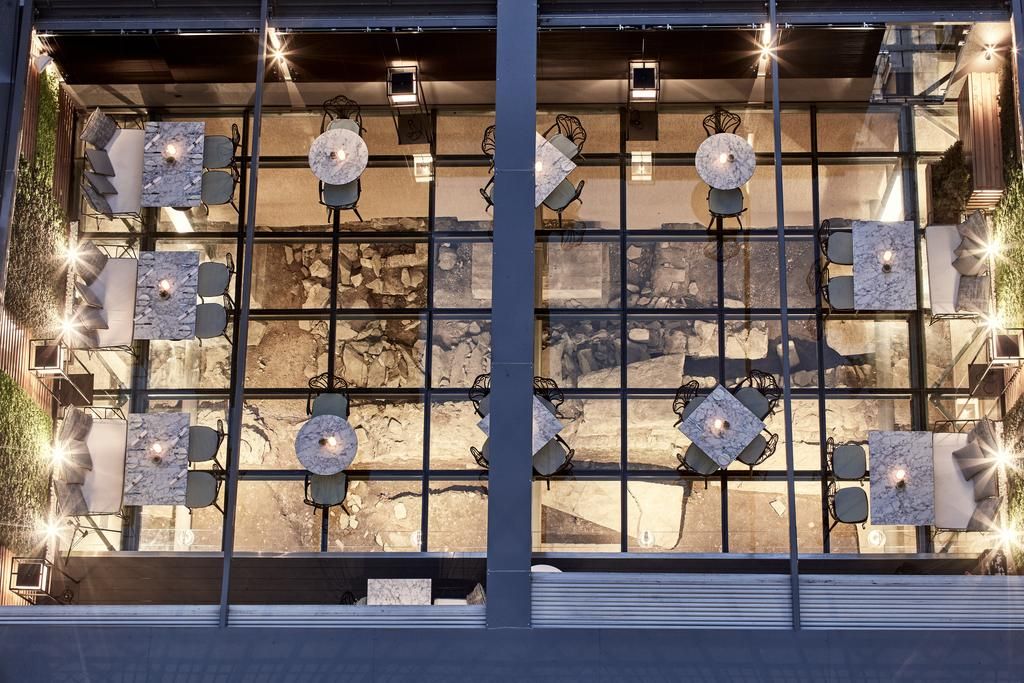
The Antigon Urban Chic Hotel is only 5-star hotel in the historic district above Egnatia street. This luxury boutique hotel – a member of the Leading Hotels of the World group, occupies a gorgeous building from the 1930’s – full of character and attention to detail. The hotel’s elegant bistro has a glass floor, revealing the Roman ruins found during the extensive restoration. There is also a rooftop champagne bar. The hotel serves a lovely buffet breakfast. Guests love it and give it top marks – you can read them, and check availability and prices, here.


[…] to the Port – a great destination in itself, and close to the Ano Ladadika, Valaoritou, and the Roman Agora district for further […]